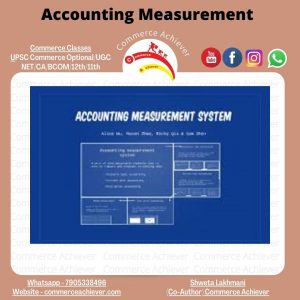
Accounting Measurement-Meaning,Definition,Examples,Principles of Accounting Measurement,three elements of measurement (Commerce Achiever)
 Measurement is a vital aspect of accounting.All transactions and events are measured in terms of money. A measurement discipline deals with the identification of objects and events to be measured, selection of standards or scale to be used, and evaluation of dimension of measurement standard or scale.
Measurement is a vital aspect of accounting.All transactions and events are measured in terms of money. A measurement discipline deals with the identification of objects and events to be measured, selection of standards or scale to be used, and evaluation of dimension of measurement standard or scale.
Prof. R.J. Chambers has defined measurement as ‘assignment of numbers to objects and events according to rules specifying the property to be measured, the scale to be used and the dimension of the unit.’
As per the above definition, there are three elements of measurement i.e.
- Identification of objects and events to be measured
- Selection of standard or scale to be used
- Evaluation of dimension of measurement standard or scale.
Accounting measurement is the calculation of economic or financial activities in terms of money, hours or other units. Overall, accounting measurement is more than just an element that helps with comparing and evaluation of data in accounting.
Accounting information provides useful measures of performance and financial position. Therefore it needs to provide information about value: the value of an entire business, the value of assets and liabilities, etc.
Principles of Accounting Measurement
Accounting measurement runs on certain principles. There are basic principles :
Objectivity: The principle of objectivity is one of the most important and pervasive principles of accounting measurement. It states that financial accounting information must be verifiable and reliable. It requires that values of transactions and of the assets and liabilities to objectively determined and backed by documented evidence.
Although it ensures that the dollar amounts disclosed in the financial statements are reasonably reliable. The principle of objectivity also precludes much relevant and useful information from ever appearing on the financial statements.
Matching: The matching principle states that the efforts of a given period must match against the benefits that result from the matching principle. Whenever a company incurs a cost to generate benefits, normally in the form of revenues initiated by it.
If the revenues are generated immediately, then the cost is treated as an expense appearing on the income statement of the current period. If the revenues are expected to be realized in future periods, the cost is considered an asset, or capitalized, and appears on the balance sheet.
Revenue recognition: The principle of revenue recognition determines at which of the four points i.e. (1) ordered, (2) produced, (3) transferred to the buyer, and then (4) paid for by the buyer.
Consistency: The principle of consistency states that, although there is a considerable choice among methods, companies should choose a set of methods and use them from one period to the next.
Its primary economic rationale is that consistency helps investors, creditors, and other interested parties to compare measures of performance and financial position across time periods.
What is Measurement?
Measurement is related to valuation and recording and is a process of collecting various figures and information in the process of accounting measurement. The measurement has become a subject of research since the nineteenth century. Ever since measurement of accounting is multidimensional. Accounting and measurements differently interpret values and measurements.
Example of Accounting and Measurement
Two business entities are having sales of Rs.100,000. Entity A may achieve this with two salespeople and entity B may achieve it with ten . Therefore, consequently, entity A’s sales team is much more productive, bringing in Rs.50,000 per salesperson per week. \Whereas only Rs.10,000 per salesperson per week for entity B.
On the other hand, if entity A has a total of 200 employees, and entity B has a total of 100, then entity A is achieving only Rs.500 per employee (Rs.100,000/200 and entity B is achieving Rs.1000 per employee (Rs.1,00,000/100). Hence, this might suggest that entity A has too much administrative overhead or that entity B runs a very efficient operation.
Tag:Accounting Measurement, CAfoundation, CAfoundationaAccounts, CAfoundationClasses, CAfoundationEconomic, CAfoundationFees, CAfoundationLaw, CAfoundationRegistration, commerce, commerceachiever, CommerceAndAccountancy, CommerceBaba, Principles of Accounting Measurement, three elements of measurement



